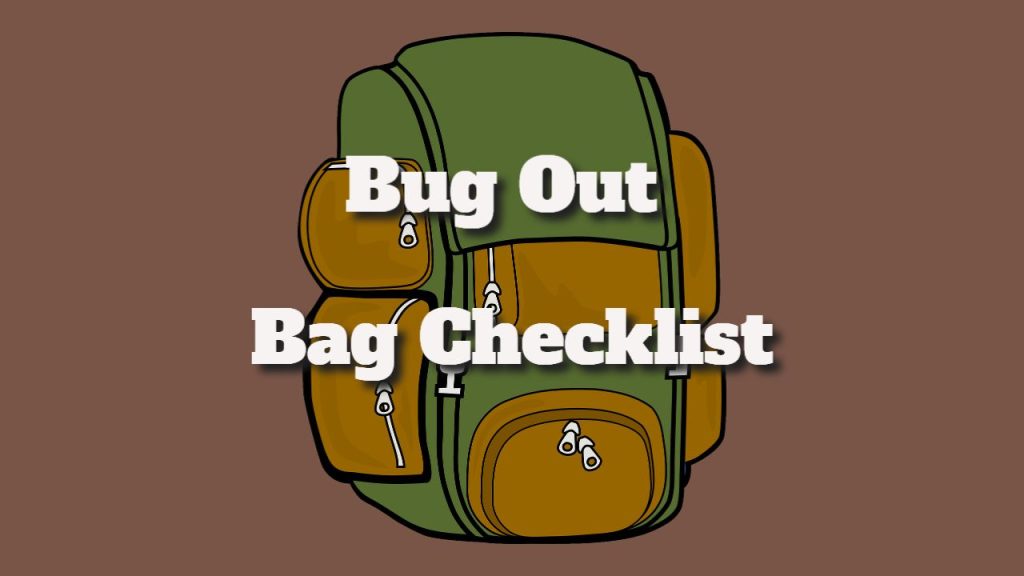Bug Out Bag Checklist
We rarely have to plan for emergencies. It is something no one wants to think about. Nobody wants to be in a situation that puts their life at peril!
What would happen if you were put in such a situation? A natural calamity is imminent, and your home is unsafe.
You may have to leave your current location. A bug-out bag is essential in this case.
An emergency kit like this can help you survive and move quickly if you’re in urgent danger.
In this article, we created a bug-out bag checklist and highlighted the significance of this type of gear.
What is a bug-out bag?
A bug-out bag has several distinct names. It may also be known as:
Prepare an emergency bag.
72-hour bag.
Go bag.
Evacuation bag.
Survival bag.
It is a single emergency survival pack—a “jack of all trades” gear that may be used in various scenarios.
Where did the term come from?
The term “bug out” originated with the United States Military and the Korean War. Soldiers were instructed to leave if their defensive position was overrun.
They would then run to safety and take a new position. Several military units have since adopted the word. Many military organisations use the phrase “bail-out” as an alternative.
What is the use of a bug-out bag?
The primary purpose of a bug-out bag is to allow you to depart your current location quickly in the event of an emergency or tragedy.
You can flee as quickly as feasible with a bug-out pack checklist and an equipped backpack. As a result, your chances of becoming hurt or caught up in the approaching event are significantly lowered.
But what type of calamities are we referring to? We’ve included a few examples below for your convenience:
Hurricanes.
Landslides.
Earthquakes.
Tsunamis.
Flooding.
Severe blizzards.
War.
Essentially, any natural tragedy and human-caused conflict. If you live in a location prone to storms or tornadoes, you may need a bug-out pack checklist.
Alternatively, you could live in a region of open conflict with potential escalation.
Whatever the reason, a bug-out bag enables you to respond quickly. You can save a significant amount of time when obtaining supplies. Your rucksack already contains everything you’ll need.
You can easily pick it up, strap it on, and get it out safely. This is why creating a bug-out pack checklist and planning your supplies is vital.
Bug Out Bag Checklist: Essentials
So, what should you include on your bug-out kit checklist? We structured our checklist into categories to make it easier to digest:
Hydration.
Food supply.
Clothing.
Shelter.
Heating.
First aid.
Hygiene.
Tools.
Lighting.
Communications.
Travel equipment.
Hydration
Water is the most essential thing in a bug-out bag. Humans cannot survive without water for longer than 72 hours. Your bug-out pack checklist should include at least 3 litres of drinking water (enough for 72 hours), a water bottle, and a water filter.
We offer a guide to the best water filters available. When your primary water supply runs out, you can use these beautiful gadgets to filter stream and lake water for drinking.
Food Supplies
Next, we have food supplies. Although the human body can do without meals for three weeks, having a food supply can help you stay energised and active.
The most important thing to remember here is to pack non-perishable food. If you pack your bug-out bag with perishable items, they may spoil rapidly, and you may run out of food entirely.
Ideally, you’ll want enough food to last at least 72 hours. Energy bars are a great food to have.
They are tiny, portable, and non-perishable, giving the nutrition you require to keep going. There are also some dehydrated foods available.
Summit to Eat, for example, creates a queue of dried meals that only require water to prepare. These are wonderful if you have extra water on hand.
Clothing
Clothing is another major category. You will need a choice of clothing to suit the weather conditions. The best idea we can make is to work in layers. Layering your clothes allows you to adjust to shifting situations more quickly.
Prepare appropriate attire for your location. For example, clothing requirements in Mexico would be vastly different from those in Northern Europe.
Finally, it is recommended to pack two changes of clothing. This means you’ll always have a dry suit ready to go.
Clothing essentials include:
Pants.
Socks.
Waterproof trousers.
Fleece.
Long-sleeved shirt.
Waterproof gloves and cap.
Waterproof jacket.
Ideally, you want a waterproof outer layer and comfortable but warm underlayers.
Shelter
You can construct a shelter out of several materials. You may require extra energy or focus to complete the task in an emergency.
In addition, having a comfortable area to sleep and rest is critical in these circumstances.
As a result, having enough shelter is an essential item on your bug-out bag checklist. This should consist of a tent, sleeping bag, and blanket.
The tent and sleeping bag should be waterproof, lightweight, and easy to transport in your backpack.
A tarp and ground pad may also be acceptable, depending on your location and temperature.
These might provide extra protection if there is a significant chance of rain or bad weather.
Keeping warm is essential when you’ve escaped the safety and comfort of your home. People can develop hypothermia and other diseases abruptly.
As a result, some heating system is required. At the very least, you should be capable of starting a campfire.
It is also critical to have a range of campfire-starting techniques. Even if one fails, you still have a backup. You cannot start a fire if you bring one ignition source and it breaks.
As a result, your bug-out bag checklist should include:
- Three ignition sources (lighters, for example).
- There are three types of fuel.
- Waterproof storage to keep them in.
First Aid.
Regardless of the situation, a first aid kit is always a good idea. For example, we recommend packing a first aid kit if you are going wild camping. Alternatively, having a first aid kit in your car is an excellent idea. As a result, including a first aid kit in your bug-out bag is equally important.
You can buy many little kits online, like this Mini First Aid Kit. The kit contains 92 things, including scissors, plasters, an emergency blanket, tweezers, bandages, respirators, and tape.
A first aid kit can help you quickly treat minor injuries such as cuts, which can get infections if not addressed.
If you live in an area where mosquitoes and other insects are prevalent, bring a small container of insect-repellent spray.
Hygiene
It is not necessary to say immaculately clean during an emergency evacuation. However, having basic hygiene supplies can help you avoid infections and rapidly declining health.
At a minimum, we recommend having:
Hand sanitiser.
A bar of soap.
Small towel.
A package of tissues.
Travel toilet paper.
Toothpaste and toothbrush.
These critical products allow you to maintain basic personal hygiene while occupying minimal space in your bug-out kit.
Tools
A minimal set of tools can be helpful in an emergency. For example, what if you brought tinned food but cannot open it? Or what if you need to cut some firewood for a campfire? Tools are invaluable and can be applied in a variety of scenarios.
The tools below are suitable for your bug-out bag checklist:
Camp knife.
Penknife or multitool.
Camping hatchet.
A little camping knife or penknife is handy for general survival purposes. Examples include opening tins, cutting bandages, and chopping smaller campfire fuel.
A hatchet can also gather firewood and clear a route through rugged terrain.
Lighting
Having multiple lighting options is just as important as having a heat source. Having a backup plan in place and double-checking essential items is recommended.
Lighting is essential and can help you evacuate swiftly and safely. It will also be helpful if you’ve evacuated and are in the woods. It also allows you to evacuate at night safely.
There are several types of illumination available. However, we recommend fitting an LED headlamp.
This gives an excellent light source without using your hands. An LED torch is also helpful to have.
In addition to these illumination products, we recommend having a supply of spare batteries. Check the light’s battery type and keep a few packs in your emergency bag.
Communications
Having a mechanism to communicate with the outside world is essential in an emergency. You can tell people where you are. You can also keep them updated or help others escape danger.
First and foremost, owning a cell phone is essential. In most circumstances, you should be able to use your phone regardless of the situation.
A mobile phone is usually the quickest approach to get assistance and assess your situation. For example, you can receive live news updates or call emergency services.
However, we recommend having a second SIM card and a burner phone. Keeping a backup phone and SIM card in your purse can be helpful if your primary smartphone fails.
Also, consider the power supply. We recommend bringing a solar power bank and a portable charger for your smartphone.
Travel Equipment
Finally, you can take some standard travel supplies that may be handy in an emergency. This includes:
Cash stashed in little bills.
Coin stash.
A map of your local area.
Compass.
Pen/pencil.
Notepad.
Emergency whistle.
Having a small amount of cash is essential since it allows you to buy supplies or transportation if you arrive in a safe location.
If your smartphone lacks GPS or Google Maps, a map of your surroundings and a compass might help you navigate.
Finally, writing equipment is frequently helpful in a variety of circumstances.
Adapt your bug-out package to your specific area and circumstances.
Remember to be adaptive, even though the above is a thorough bug-out bag checklist.
Your bug-out bag should reflect your current location and situation. You may want to carry alternative clothing if you live in a more excellent region.
Think about your surroundings. Is there a significant seasonal weather variation?
What are the average temperatures throughout the year? Are any natural disasters more common in your area?
Use this information to update your bug-out bag checklist.
Prepare an emergency kit!
Creating a bug-out bag checklist is a great idea. It can help you quickly prepare for an emergency and ensure you have all you need to live.
A bug-out bag will not allow you to survive indefinitely, but it will help you in the near term until additional assistance arrives.
If you enjoy wild camping and spend a lot of time in the woods, an emergency kit can come in helpful.
The Article Bug Out Bag Checklist Appeared First On Survival Avenue.
The post Bug Out Bag Checklist appeared first on Survival Bite.
The Article Bug Out Bag Checklist was found on https://limitsofstrategy.com
The Article Bug Out Bag Checklist First Appeared ON
: https://ad4sc.com



